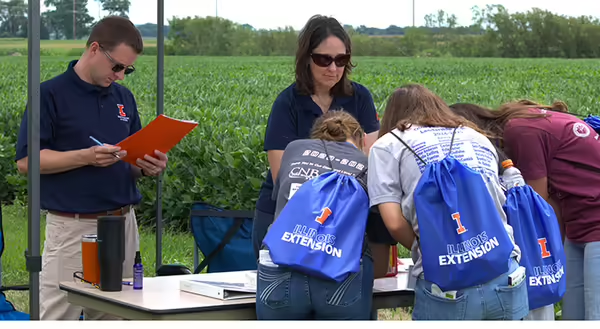
The University of Illinois recently hosted the Youth Crop Scouting Competition at the Urbana-Champaign South Farm. Student teams of two to five high-school-aged youth with an adult coach rotated through 10 outdoor stations to test their hands-on agronomy skills. Topics included identifying weeds, insects, and diseases, identifying the growth stages of corn and soybean plants, assessing abiotic injury, pesticide safety, pesticide application, and integrated pest management. Teams were scored by judges, including University faculty, graduate students, specialists, and Extension educators.
This year, there were four teams, and the competition was fierce. Each team went home with event T-shirts and a cash prize. One team planned an ice cream stop before leaving the area to reward their hard work. I’d say it was a good day for all.
Pesticide Safety Education Program Extension Specialists served as pesticide safety station judges. This is an event we look forward to every year. It’s fun to work with the youth and see what they know. The light bulb moments are particularly good, and sometimes they will surprise you. After watching one team member wrinkle up their face a few times while being asked some challenging questions at our pesticides station, I was convinced the day may not be going well for them so far. But once the team completed their tasks, that same person quickly announced, “I like this one!”, meaning our station. After all the time we invested in it, that was rewarding.
The pesticide safety station serves a two-fold purpose: to see what they know and to see what they can figure out. Some questions are based on general pesticide safety knowledge, while others focus on a few pesticide labels. Contestants need to work as a team to use the pesticide labels before them to answer the questions correctly. Additionally, we hope they learn a few things along the way.
While you wouldn’t think that high schoolers would know much about pesticide use, we are always surprised to hear them tell stories of their personal experiences. One girl was quick to tell us that she has firsthand experience using one of the products displayed to protect her grapes from Japanese beetle damage. While discussing that, we told her about other non-chemical tactics for dealing with these beetles, such as knocking them into a bucket of soapy water in the morning or evening, and removing the first damaged leaves, as beetles flying over are attracted to these and then fly in to feed.
One question proposed a scenario where their little brother accidentally drank a pesticide improperly stored in a soda bottle. The thought of your little brother accidentally drinking pesticide certainly gets your attention. But what to do in that situation? We had them locate the first aid information in the label directions. Now, if they find themselves in a similar situation, they’ll know where to get help. Most importantly, they’ll know that pesticides should never be stored in food or beverage containers and hopefully relay that information to others.
This year’s top two winning teams, Richland County and Pontiac FFA Chapter, will compete at the regional contest in Iowa on Sept. 13. If you would like to enter a team in next year’s competition, be sure to watch the website next spring for details or reach out to Meagan Diss, competition coordinator at mcdiss@illinois.edu, 217-300-5386.
Read more in the news release from Illinois Extension.
ABOUT THE AUTHOR: Michelle Wiesbrook provides subject matter expertise and training in pesticide safety with an emphasis on horticultural weed science. She serves as the Illinois Pesticide Review newsletter editor, collecting and organizing material; and co-coordinates social media information for the PSEP program and ensures its timely publication. Her other interests include herbicide injury and invasive species.